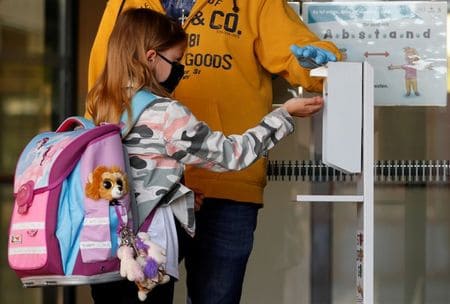 During the early months of the U.S. Covid-19 pandemic, exposure to child care for children ˂6 years old was not associated with an increased risk of transmission for their care providers, according to a recent study published in Pediatrics. This finding supports previous findings that young children are less likely to transmit Covid-19.
During the early months of the U.S. Covid-19 pandemic, exposure to child care for children ˂6 years old was not associated with an increased risk of transmission for their care providers, according to a recent study published in Pediatrics. This finding supports previous findings that young children are less likely to transmit Covid-19.
Upon conducting a large, multistate canvass of the U.S. child care workforce, Gilliam and colleagues included Covid-19 results from 57,335 U.S. child care providers, of whom 427 had tested positive or been hospitalized for Covid-19. They also assessed the degree of exposure of these participants to child care, and controlled for background transmission rates, demographic and community variables.
“This is the first known study to estimate directly Covid-19 transmission within child care programs while addressing current research limitations by focusing on transmission opportunity through children actively participating in out-of-home programs and therefore not shielded from Covid-19,” wrote lead author Walter S. Gilliam, PhD, of Yale Child Study Center, School of Medicine, Yale University, New Haven, Connecticut.
They found no association between exposure to child care and Covid-19 in their analyses, both matched (OR: 0.94; 95% CI: 0.73-1.21) and unmatched (OR: 1.06; 95% CI: 0.82-1.38). Compared with center-based providers, however, they did find that home-based providers did have an association with Covid-19 infection (OR: 1.59; 95% CI: 1.14-2.23).
An important finding in this study was that 51.4% of participants reported that their child care program had been closed near the beginning of the pandemic and remained closed until the time of the survey. Among those whose child care programs had not closed, groups sizes were smaller than usual and infection mitigation efforts were in place, including frequent staff and child hand-washing and daily disinfection of indoor surfaces and fixtures (at least 3 times daily). Symptom screening and distancing measures were also been implemented. Further, most children in the programs that remained open were less than 6 years old.
Commenting on these results, Gilliam et al noted: “Although it is unclear whether any of these mitigation efforts significantly reduced transmission, there is no way to know whether these findings would hold in the absence of these infection mitigation efforts. Likewise, these results should not be applied to kindergarten to 12th-grade schools or universities, where students and contexts vary significantly from child care.”
In their unmatched analyses, Gilliam and colleagues found that Covid-19 was associated with high levels of county-level cumulative per capita deaths from Covid-19 (OR: 1.60; 95% CI: 1.19-2.15; P=0.002), as was being of American Indian or Alaskan native ethnicity (OR: 2.37; 95% CI: 1.46-3.86; P=0.001), Latinx (OR: 213; 95% CI: 1.63-2.77; P˂0.001), or African American (OR: 1.97; 95% CI: 1.53-2.53; P˂0.001).
Protective effects were seen with adherence to avoiding high-risk situations and travel (OR; 0.72; 95% CI: 0.62-0.84; P˂0.001). Avoiding social interaction at family gatherings or restaurants, for example, was a risk factor (OR: 1.27; 95% CI: 1.13-1.44; P=0.001). Gilliam and fellow researchers noted that this was “perhaps because opportunities to attend these were dependent on local transmission rates and business closures.”
In an accompanying editorial, Heather L. Tubbs-Cooley, PhD, RN, FAAN, of The Ohio State University, Columbus, OH, and colleagues wrote: “The study adds to the body of literature on Covid-19 transmission in child care settings in notable ways. First, it focuses on child care providers rather than children, providing crucial evidence to understand risks to adults working in direct contact with young children.”
They caution, however, that these results are not applicable to older children.
“We caution policy makers, school leaders, and the general public against extending these findings beyond the early childhood (age 6) population. The authors are clear (and we affirm) the results cannot be directly applied to debates on reopening kindergarten to 12th-grade schools because student, teacher, and classroom dynamics differ from child care settings in ways that meaningfully influence infection transmission (eg, increased movement of students between classrooms, increased out-of-school mobility and social activity of adolescents, more adults in the school environment),” wrote Tubbs-Cooley and colleagues.
Nevertheless, the results from Gilliam and colleagues are of importance for U.S. adults providing child care for the youngest children.
“The results from this study should give confidence to center-based child care providers that the risk of Covid-19 infection from young children is low when community transmission is low and multiple risk mitigation strategies are employed,” concluded Tubbs-Cooley et al.
Study limitations include a not fully representative sample, policy-level variables that may not have been adequately controlled, timing of data gathering (spring/fall 2020), possibility of asymptomatic infection, and reliance on self-reported test results.
- Exposure to center-based child care for children <6 years of age during the early months of the U.S. pandemic was not associated with an elevated risk for Covid-19 transmission to providers.
- This is the first study to directly estimate the risks of Covid-19 transmission in child care programs for adult caregivers, rather than the children being cared for, but they urge caution in extending these findings to older age groups.
E.C. Meszaros, Contributing Writer, BreakingMED™
This study was supported by the Andrew and Julie Klingenstein Family Fund, the Esther A. and Joseph Klingenstein Fund, the Heising-Simons Foundation, the W.K. Kellogg Foundation, the Foundation for Child Development, the Early Educator Investment Collaborative, Scholastic Inc, the Yale Institute for Global Health, and the Tobin Center for Economic Policy at Yale University.
Gilliam and Tubbs-Cooley reported no financial disclosures.
Cat ID: 926
Topic ID: 79,926,933,926,138,927,928,934


